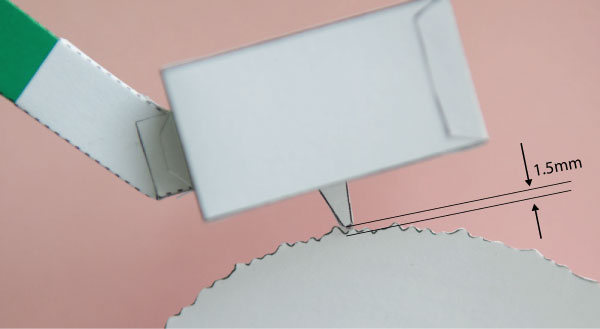Time for a quick recapitulation:
I've made a sound recording of myself saying "hello" and stretched out the waveform in Audacity so that all the peaks and troughs are clearly visible.

I traced the waveform in Illustrator then wrapped it round in a circle.

I constructed a paper horn in the hope that I would be able to play the sound back.

The end of the horn has a read head which follows along the waveform hopefully playing back the sound "hello" from the paper disk.

The problem, and it's a big 'un, is that it doesn't work. I turn the disk and get nothing but a distorted scraping sound from the horn. No nuance over the circumference of the disk, not even a hint of recognisable speech. Pah.

So why doesn't it work? I'm not sure but perhaps the application of some physics might shed some light…
In its current form the read head has to move up and down a maximum of roughly 1.5mm. The head is pushed up the waveform hills by the contours of the disk and falls back into the the next valley through the power of gravity. I began to wonder just how fast the read head could move using gravity as its power source. Here is the equation used to work out how long it takes to fall a given distance in any particular gravity field.
t = √(2d/g) where t is time in seconds, d is distance fallen and g is acceleration due to gravity.
To save the effort of having to actually do any calculation I found this wonderful website:
www.gravitycomp.com which works out all sorts of gravity related calculations anywhere from the Sun to Neptune with, of course, a section for planet Earth. Isn't the internet a marvel!
The read head falls a maximum of approx. 1.5mm, plugging in this information into the appropriate box on gravitycomp.com gives a fall time of 0.0175 secs. It sounds fast, but is actually a problem.
Double that time for a full up/down cycle giving a total time of 0.035 seconds for a full cycle which means that the fastest possible vibration speed of the read head is just over 26 cycles per second (26 Hz) This is at the low end of human hearing and certainly too deep to be useful in the playback I was hoping to create.

Where next?
I'm not sure. Talking to my Dad about it he pointed out that the groove in vinyl records move side to side, not up and down so gravity doesn't come into it. Also they are also considerably smaller than the paper wave form that I made. I found this picture on www.synthgear.com. Using the scale at the bottom of the

electron-micrograph it looks like the maximum movement is around thirty micrometers, a factor of fifty times smaller and well out of the range of cutting out with scissors. I don't want to accept defeat yet. It would be really cool if I could get an entirely paper playback device working so I'll be spending some time thinking about and researching this. It the meantime, any ideas? Any suggestions?


